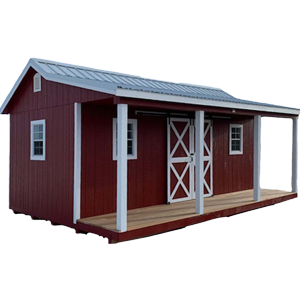Fresh Herbs in a Greenhouse: Tips for Year-Round Success
by Dakota Storage Buildings, on April 14, 2025

If you’re cooking is one of your favorite hobbies — or you just want to save on grocery bills — growing herbs in a greenhouse is a smart way to ensure a steady supply of fresh, flavorful ingredients right at your fingertips.
Greenhouses provide a controlled environment that shields plants from harsh weather, pests, and other challenges that can hinder growth outdoors. Plus, you can tweak the conditions to keep your herbs thriving all year round!
Imagine snipping fresh basil for your pasta, mint for your tea, or rosemary for your roasted vegetables any time of year. With a little effort and the right techniques, your greenhouse can become a thriving space that enhances your meals, saves you money, and elevates your herb gardening skills.
Top Herbs To Grow in Your Year-Round Greenhouse
Greenhouses create an ideal environment for a variety of herbs by ensuring they have the right conditions to thrive even when outdoor weather is less favorable. Here are some of the best herbs for greenhouse cultivation.

Basil
Basil loves warm, humid conditions and grows quickly when given plenty of light and consistent moisture. This aromatic herb is perfect for adding fresh flavor to pasta, pesto, and salads.
In a greenhouse, basil thrives when kept at temperatures between 70°F and 85°F. Regular pruning encourages bushy growth and prevents it from flowering too early.
Mint
Mint thrives in partial shade and spreads easily, making it both a blessing and a challenge. Its fast-growing nature means it can quickly take over a space if not contained, so we recommend planting it in separate containers.
Greenhouse-grown mint needs consistent humidity and well-watered soil to give you an endless supply for teas, cocktails, and desserts.
Parsley
Parsley is a versatile herb used in everything from soups and stews to garnishes.
In a year-round greenhouse, parsley grows well when temperatures stay between 50°F and 70°F. By harvesting it regularly, you can promote new growth. Its hardy nature means it can provide fresh leaves for months at a time.
Thyme
Thyme flourishes in well-drained soil and bright light, making it an ideal candidate for greenhouse cultivation. This woody herb adds depth to roasted meats, vegetables, and sauces.
Its drought-tolerant nature means it requires less frequent watering, and its compact size makes it easy to grow alongside other herbs.
Cilantro
Cilantro needs cooler temperatures and ample moisture, thriving in conditions between 50°F and 75°F. Known for its bright, citrusy flavor, cilantro is essential for salsas, curries, and salads.
Because it has a short growing cycle, planting successive batches ensures a continuous supply throughout the year.
Rosemary
Rosemary requires plenty of light and well-drained soil, making it well-suited to the bright, dry environment of a greenhouse. This hardy herb adds a pine-like aroma to breads, roasts, and grilled dishes.
Rosemary’s woody stems benefit from occasional trimming to maintain a compact shape and encourage new growth.
These six herbs are well-suited to the controlled environment of a greenhouse, where temperature, light, and humidity can be carefully managed. When selecting herbs, consider your local climate, culinary needs, and personal preferences to create a well-rounded greenhouse herb garden.
Essential Herb Care Tips for Thriving Plants
Successfully growing herbs in a greenhouse requires attention to detail and proper care techniques. Here’s how to get started.

Choosing the Right Soil and Containers
Herbs need well-draining soil to prevent root rot. Use a high-quality potting mix with added perlite or sand for better drainage. Containers should have drainage holes at the bottom to allow excess water to escape. Rotating containers periodically ensures even light exposure and healthy growth.
Consider using raised beds or vertical planters to maximize space, especially if your greenhouse is small.
Managing Light and Temperature
Herbs thrive in bright, indirect light. During short winter days, supplement natural sunlight with grow lights to maintain optimal light levels. LED grow lights are energy-efficient and provide the full spectrum of light that herbs need for photosynthesis.
Most herbs prefer temperatures between 60°F and 75°F. Installing a thermostat helps maintain consistent temperatures, while shade cloths can be used in summer to prevent overheating.
Ensuring Proper Water and Fertilizer
Overwatering is a common mistake when growing herbs. Water your plants when the top inch of soil feels dry. Using a drip irrigation system can help provide consistent moisture without overwatering.
Organic fertilizers, such as compost tea or fish emulsion, supply essential nutrients. Apply fertilizers every few weeks, but avoid overfeeding because it can lead to leggy growth.
Preventing Pests and Diseases
Year-round greenhouses can sometimes attract pests like aphids, spider mites, and whiteflies. Regularly inspect plants for signs of infestation and remove affected leaves immediately. Introduce beneficial insects, such as ladybugs, to control pest populations naturally.
Ensure good air circulation with proper ventilation and spacing between plants to help prevent fungal diseases. Regularly clean your greenhouse surfaces and tools to minimize the risk of disease.
How to Harvest and Store Fresh Herbs From Your Greenhouse
Harvesting herbs in a greenhouse at the right time ensures maximum flavor and encourages new growth. The best time to harvest is in the morning when the essential oils are most concentrated. Use sharp scissors or pruning shears to cut herbs just above a leaf node.
To store your fresh herbs for longer periods of time, dry the herbs by hanging them upside down in a well-ventilated area, freeze them in airtight containers, or create infused oils by soaking herbs in olive oil.
Proper storage preserves the flavor and extends the usability of your herbs, allowing you to enjoy homegrown goodness even when fresh harvesting is not possible.
3 Quick Steps to Properly Store Fresh Herbs
- Drying: Hang small bunches upside down in a dry, dark place.
- Freezing: Chop herbs and freeze them in ice cube trays with water or oil.
- Infused Oils: Store herbs in olive oil for flavored cooking oils.
These methods help preserve the freshness and potency of your herbs long after harvesting.
Fresh Herbs That Take Your Everyday Meals to the Next Level

Fresh herbs can transform everyday meals into gourmet experiences. Basil adds a sweet, peppery flavor to pizzas and pasta sauces. Mint enhances salads, beverages, and desserts. Parsley brightens up soups, stews, and grilled meats. Thyme provides a subtle earthiness to roasted vegetables and poultry. Cilantro is essential for salsas, curries, and tacos, while rosemary pairs perfectly with roasted potatoes and bread.
Don’t be afraid to get creative with your cooking by experimenting with different combinations of herbs with butter and vinegar.
Health Benefits of Growing and Using Fresh Herbs
Fresh herbs not only enhance flavors, but they also offer a variety of health benefits that can support your overall well-being.
- Basil is known for its anti-inflammatory properties and is rich in antioxidants that help protect cells from damage.
- Mint can aid digestion and soothe upset stomachs, making it a great addition to teas or after-meal snacks.
- Parsley is packed with vitamins A, C, and K, which support immune health, bone strength, and clear skin.
- Thyme contains antimicrobial properties that can help boost immunity and fight infections.
- Cilantro is known for its detoxifying effects, helping to remove heavy metals from the body.
- Rosemary has been linked to improved memory and concentration.
Incorporating fresh herbs into your cooking enhances your meals and provides a natural boost to your health.
Enjoy Fresh Herbs All Year Long With Greenhouse Gardening
From saving money on store-bought herbs to enjoying superior flavor and freshness in your meals, growing herbs in a greenhouse has so many benefits. With proper care, the right herb selection, and effective storage techniques, your greenhouse can provide a year-round supply of aromatic and flavorful herbs.
Ready to start your herb-growing journey? Explore our year-round greenhouse options today and take the first step toward creating a lush, productive herb garden that enhances your kitchen every season.

























